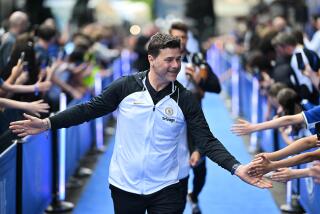Different Plan, Different Man vs. Germans
- Share via
PARIS — How do you attack Germany’s defense?
That has been the topic of discussion all week among U.S. Coach Steve Sampson and his three World Cup assistants, Clive Charles, Thomas Rongen and Milutin Soskic.
Soskic doesn’t figure into the discussions much, though, because he’s the goalkeeper coach, and his job has more to do with figuring how to stop Germany’s attack on the U.S. team on Monday.
But the three others have been trying to solve the puzzle of the German defense. In the Americans’ favor, one of Germany’s best defenders, sweeper Matthais Sammer, failed to make the team because of the lingering effects of a knee injury.
And other injuries in the last few days have affected Coach Berti Vogts’ team, currently sunning itself in Nice on the French Riviera. Defender Thomas Helmer has been bothered by a right thigh injury and left wingback Christian Ziege has been running a fever.
Hans-Willhelm Mueller-Wohlfahrt, the German team doctor when he’s not busy counting to see if he’s lost any words from his name, has been kept busy.
Of course, Germany has depth at every position, and it’s not as if the defense will struggle if it has to depend on the likes of 1990 World Cup winners Lothar Matthaus and Juergen Kohler.
But Matthaus is 37 and Kohler turned 33 on Wednesday. Asking either of them to keep up with such speed burners as, say, Cobi Jones, who turns 28 the day after the game, or 23-year-old Frankie Hejduk may be asking a lot.
Which is why Sampson, Charles and Rongen have been putting their heads together and looking for ways to get behind the German defense. Basically, there are three routes: direct, by the backdoor and by air.
Each requires a different striker or target man up front.
If the U.S. wants to go the direct route, it must play Eric Wynalda.
“Eric has the ability to be very deceptive on the dribble, to create that little bit of space for himself to either pass or to shoot it,” Sampson said. “That first step, when he’s in form, is very difficult to defend.
“I would say he’s our best striker facing the goal.”
If the U.S. wants to go around the wings, Roy Wegerle is the likely starter.
“Roy Wegerle, I believe, is our best striker with his back to goal, and his ability to hold the ball against the pressure of the defense,” Sampson said. “His ability with his first touch to buy himself a little bit of time and keep possession. It’s so important in that center forward position to keep possession.
“He’s also is a clinical finisher, once he gets in behind the defense. An area where I would like to see him improve is his ability to strike balls over distance in front of the defense.
“But if he’s able to combine [with another player] to get behind, there’s no better person I would want one versus one against the goalkeeper than Roy Wegerle.”
If the U.S. chooses the aerial route, Brian McBride comes into the picture.
“If I had to rank ability in the air,” Sampson said, “I would rank McBride, Wegerle, Wynalda, in that order.”
Chances are, the United States will try to use the speed of Jones and Hejduk on the flanks and Ernie Stewart in the middle to break through Germany’s defense. That plan worked in a 3-0 victory over Austria at Vienna in April.
Wegerle and McBride each played a half in that game, with McBride looking especially useful.
But Germany is not Austria. Its players are several notches above. And in any case, Sampson, Charles and Rongen are assuming the U.S. will even be given a chance to attack.
For all they know, the traffic at the Parc des Princes on Monday might all be going the other way. Perhaps Soskic is the one doing the important planning after all.
More to Read
Go beyond the scoreboard
Get the latest on L.A.'s teams in the daily Sports Report newsletter.
You may occasionally receive promotional content from the Los Angeles Times.






